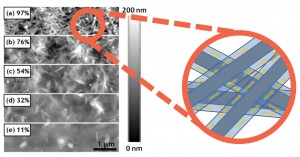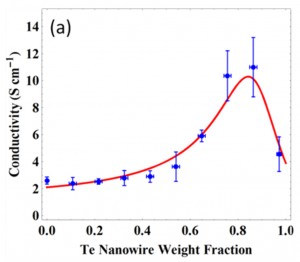Composite Organic/Inorganic Thermoelectric is More Than Sum of Its Parts
May 06, 2013
Science Short
A team led by Berkeley Lab Materials Sciences Division’s Jeffrey Urban and Rachel Segalman have discovered highly conductive polymer behavior occurring at a polymer/nanocrystal interface. The composite organic/inorganic material is a thermoelectric – a material capable of converting heat into electricity – and has a higher performance than either of its constituent materials. The results may impact not only thermoelectrics research, but also polymer/nanocrystal composites being investigated for photovoltaics, batteries, and hydrogen storage.

Atomic force micrograph of nanowire-polymer composite films of varying composition, and schematic of highly conductive interfacial phase.
An efficient thermoelectric material made from polymers and nanocrystals is an attractive prospect as it would be significantly cheaper to fabricate than traditional thermoelectrics. Here the researchers synthesized tellurium nanowires with PEDOT:PSS, a common conducting polymer, and cast thin films of the resulting solution. Intriguingly, the team found that the composite films had higher thermoelectric performance than either the polymer or nanowires alone.

High electrical conductivity is seen in composite polymer/nanowire films corresponding to an intermediate weight fraction of tellurium nanowires
The researchers rationalized their unusual results by modeling the films as a composite of three distinct materials: nanowires, bulk polymer, and a new interfacial polymer phase with increased electrical conductivity. The highly conductive interfacial polymer phase suggests new routes to enhancing electronic and thermal properties in hybrid materials and devices, for thermoelectric energy conversion and other energy applications.
# # #
“Effect of Interfacial Properties on Polymer–Nanocrystal Thermoelectric Transport,” Nelson E. Coates, Shannon K. Yee, Bryan McCulloch, Kevin C. See, Arun Majumdar, Rachel A. Segalman, and Jeffrey J. Urban, Advanced Materials 25, 1629-1633 (2012). DOI: 10.1002/adma.201203915
This work was supported through the DOE program on Nanostructured Materials for Thermoelectric Energy Conversion and was partially performed at the Molecular Foundry.
Tweets
- Cancer researcher Mina Bissell: cellular context is key (and always think outside the box). Next up: QA http://t.co/w8ECiqVVlQ >> 14 hours ago
- How to learn from nature to create better materials? Ron Zuckermann: understand folding rules of synthetic proteins http://t.co/AId3O6gBm9 >> 14 hours ago
- David Schlegal: making 3D map of universe w/ Sloan Telescope, looks at 1000 objects at once http://t.co/Xssjz55oqH working to get faster >> 14 hours ago
Legal Disclaimer:
EIN Presswire provides this news content "as is" without warranty of any kind. We do not accept any responsibility or liability for the accuracy, content, images, videos, licenses, completeness, legality, or reliability of the information contained in this article. If you have any complaints or copyright issues related to this article, kindly contact the author above.
